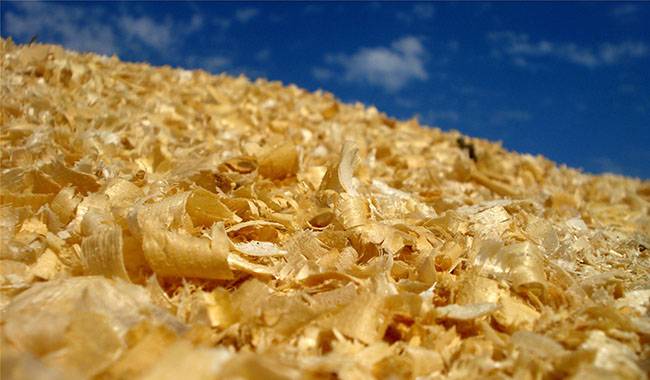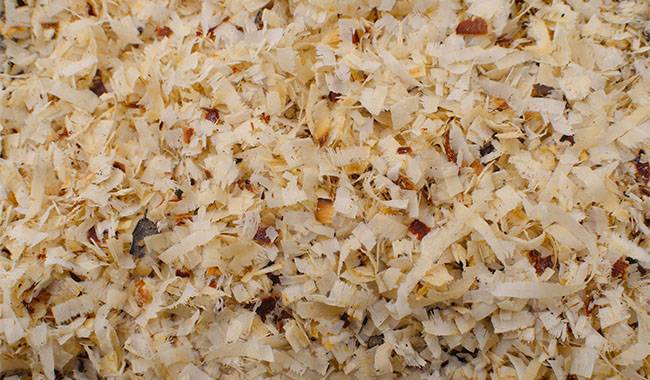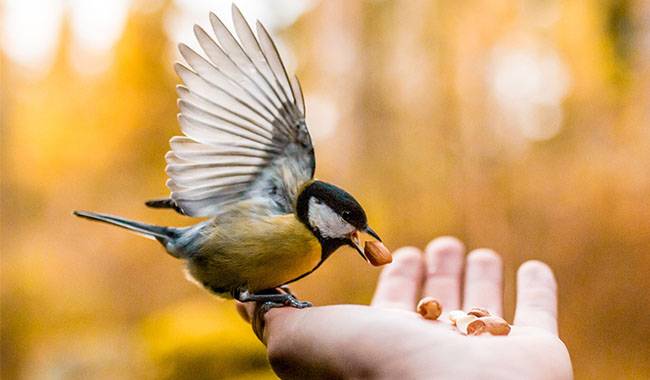
In the home, especially during construction work, sawdust waste from carpentry projects accumulates. Some young owners don’t realize how valuable the gardening materials they have on hand are and immediately send the waste into the fire and then scatter the ashes around the garden as fertilizer.
Indeed, where can you use sawdust, how can you use them, and is it worth a try? I hasten to reassure the reader. There are many ways to use sawdust in gardening.
But you must use sawdust correctly. Let’s try to figure out where and how to Uses of sawdust.
WHAT IS SAWDUST?
Sawdust is the waste material from sawing wood and other materials (plywood, boards, etc.). Sawdust material is quite light. The bulk density of sawdust is 220 Lb (100 kg) per 1 cubic meter, and 1 ton contains 9-10 cubic meters of raw material with a standard moisture content of 8-15% (Table 1). This material is very easy to handle.
Table 1. Bulk density of sawdust wood
| Bulk density of sawdust | Bulk density of sawdust per liter tank / per 2.2Lb | Standard drum (2.6Gal) per 2.2Lb | Weight of 1 cube per 2.2Lb/35 Cubic feet | Number of cubes per ton (sawdust dried), 35 Cubic feet/ton |
| Average data (excluding tree species) | 0.22Lb | 2.2Lb | 220Lb/35 Cubic feet | Large: 350 Cubic feet Small: 320 Cubic feet |
CHARACTERISTICS OF SAWDUST COMPOSITION
The chemical composition of sawdust is characterized by the content of the following chemical elements:
1. 50% carbon.
2. 44% oxygen.
3. 6% hydrogen.
4. 0.1% nitrogen.
In addition, wood contains about 27% lignin, which gives it the density of a single wood, and at least 70% hemicellulose (actually carbohydrates).
The natural organic matter that decomposes in the soil is the provider of the elements needed by plants. In 1 cubic meter of sawdust, there are 250 grams of calcium, 150-200 grams of potassium, 20 grams of nitrogen, and about 30 grams of phosphorus. Some species of sawdust (mainly conifers) contain resinous substances in the wood, which have a negative impact on plant growth and development.
Sawdust is a sterile substrate that is inhabited by microflora immediately after entering the soil. In the case of providing organic material, the microflora that decomposes sawdust use nutrients from both the wood and the soil, depleting the latter of essential nutrients (the same nitrogen and phosphorus).
The components of sawdust from natural wood do not cause allergies, and when burned, they do not emit gases harmful to health. However, it is necessary to keep in mind that the above-mentioned components are characteristic of natural wood, the quality of which determines the composition of sawdust. Sawdust as waste from artificially obtained boards impregnated with glue and paint cannot be used in horticulture.
TYPES OF SAWDUST AND THEIR USES
Sawdust is named according to the main types of woody crops: birch, linden, oak, chestnut, pine, poplar, coniferous, etc.
All types of sawdust (of any tree species) can be used on farms. But first, it is necessary to use various methods that will reduce their negative impact on the soil composition.
This is the most easily available and cheapest raw material, which has a wide range of applications in private households. Sawdust is used in the construction of outdoor buildings, for insulation of walls, floors, and other constructions.
But sawdust has its most valuable use in horticultural projects.
To improve the physical conditions of the soil in which vegetables or horticultural crops are grown:
- As one of the components of compost preparation.
- As use for mulching vegetables, flowers, and horticultural crops
- Sawdust has a very low thermal conductivity and can be used as an insulating material for heat-loving plants (roses, young fruit crops in the south, exotic plants in cold regions).
- Sawdust is an indispensable component in the preparation of warm beds.
- As a mulching material for roads, preventing the latter from being covered with weeds.
METHODS OF USING SAWDUST
Improving the physical properties of the soil
Black, clay, and loamy soils are classified as dense and heavy. Most garden plants prefer light, loose, breathable and permeable soil. To improve the quality composition of this soil, you can add up to 50% by volume of soil sawdust when preparing a greenhouse substrate or preparing a soil mixture for seedlings.
To ensure that sawdust does not reduce fertility, they are mixed with semi-digested manure or added to mineral fertilizers, urea solutions, or cowpeas before application.
Preparation of compost using sawdust
Compost preparation eliminates all the negative effects of sawdust (nutrient depletion of the soil, reduced oxidant properties, reduced resin content, etc.).
There are two ways to prepare compost:
a. obtaining a fast or aerobic compost (with air entry), which is ready for use after 1 to 2 months.
b. Anaerobic composting (without air access); this preparation process takes longer (3-6 months, depending on the composition used), but this method preserves the nutritional value of the organic matter.
Aerobic composting
In this method, you can prepare sawdust-mineral, sawdust-organic, and sawdust-mixed composts:
a. For sawdust-mineral compost, 110Lb (0.5 m3) of sawdust is added to 2.75Lb of urea, 0.88Lb of calcium superphosphate (double), and 1.65Lb of potassium sulfate. Dissolve the fertilizer in warm water and pour it over the sawdust, stirring constantly or spreading it in layers. Each layer was poured with the prepared solution. During the composting process, agitate the compost to increase the entry of air, which will accelerate the fermentation of the sawdust organic matter.
b. In order to prepare the sawdust organic compost, you will need chicken manure or manure. Organic matter is added to the sawdust at a ratio of 1:1 (by weight) and mixed or layered with the sawdust for fermentation. During the fermentation process, aerate (fluff) the pile with a pitchfork.
c. To prepare sawdust mixed compost, start with sawdust-mineral compost and add manure or chicken manure after one month of fermentation. Manure is added at a ratio of 1:1 and chicken manure at half the ratio (1:0.5).
Remember that loose packing is necessary for fast fermentation, without compaction. Compost piles like this will allow air to flow easily into the compost pile, which will accelerate the decomposition of the compost components.
If you place the compost in the spring, it will mature in the fall and be ready for application under leaf cover. You can apply semi-mature compost after 3-4 weeks. It is not yet a fertilizer, but it is already having a negative impact on the soil and plants.
Depending on soil conditions, apply 1 to 2 buckets of ready-to-use compost under re-harvest.
Anaerobic composting
In the anaerobic method, compost is prepared gradually by adding ingredients gradually. Chopped organic matter (leaves, twigs, unseeded weeds, sawdust, manure, garden stubble, food waste, etc.) is applied in a 20inch (50 cm) deep compost pit in 6-10inch (15-25 cm) layers. Each layer was covered with one or two shovels of soil and watered with a fertilizer solution. Up to 100 grams of nitrocellulose was added to each bucket of solution.
Unlike the first (aerobic) method, all components are well tamped to reduce air entry. In this case, fermentation is carried out by anaerobic microflora. Once the compost pile is complete, it is covered with aluminum foil or a layer of grass. The fermentation process takes 4-6 months. Anaerobic compost is more “nutritious” and all types of waste (including coarse twigs) are used in its preparation.
When preparing compost, the optimal moisture content of the compost should be 50-60% and the temperature 77-86°F (25-30°C).
MULCHING THE SOIL WITH SAWDUST
Mulch means to cover, to shelter in everyday life.
Advantages of using sawdust mulch.
- Sawdust mulch is an inexpensive, natural material that improves the physical properties of the soil.
- It keeps the upper layer from overheating in hot weather.
- A good insulator. It protects the soil from freezing, while freely allowing air to enter and preventing the development of decaying fungi and bacterial infections.
- Coniferous sawdust mulch promotes easy oxidation of the soil, which is important for some crops, especially flowering crops: begonias, geraniums, ivy, ficus, cyclamen, citrus, and others.
- Protects ripe berries in contact with the soil from rot and pests (slugs).
Disadvantages of sawdust mulch.
The negative characteristics of sawdust can manifest themselves if used improperly
- In its pure form, this raw material will overcompensate for 8-10 years, using soil nutrients for fermentation.
- When using sawdust in preparation for composting, high temperatures can rise rapidly.
- Continuous application of the raw material will increase the acidity of the soil.
- How to use sawdust mulch
Clean sawdust is covered only on paths and other surfaces where there are no crops. For example row spacing, paths, planting strips in gardens.
Lightweight mulch reflects sunlight and thus reduces the heating of the soil surface.
As it shrinks, add clean mulch to rows and paths. A 2-3inch (6-8 cm) layer of untreated mulch, constantly updated, prevents weed growth.
Mulch does a good job of retaining moisture in the soil and at the surface. It keeps the surface layer moist for a long time and prevents it from drying out and cracking.
Mulch is used as bedding under berries whose crops are stripped to the ground (e.g., under strawberries, strawberries).
The soil around the canopy of the cover garden crop. You can wash (untreated) sawdust – to prevent increased weed growth and compost it as organic fertilizer.
Only use treated sawdust to cover the soil under the plants.
Treated mulch (mature or semi-mature compost) should always be added only under plant rows and fruit bushes.
During the growing season, fertilize the plants on top of the sawdust. The applied fertilizer helps them to digest it faster.
After harvest, work is carried out in autumn directly on the mulch: digging the soil with a prior application of mineral fertilizers and organic matter.

USE SAWDUST MULCH TO PREPARE RAISED AND WARM BEDS
Raised beds are prepared on any site (stony, gravel, high groundwater).
Warm beds (low, ground-level) are located in cold soil, also to obtain earlier growth of heat-loving vegetables and sprouts.
Vegetable crops mature faster in such beds and they are less affected by fungal rot and insect pests.
The beds are prepared in a conventional way.
- A “drainage” layer consisting of coarse branches and other waste is laid under the base.
- The second layer is filled with sawdust and sprinkled with urea solution.
- and a few shovels of any soil.
- The next layer is laid by any other organic material – straw, manure, shredded weeds, fallen leaves.
- The thickness of each layer is 4-6inch (10-15 cm), and the total height of the bed – is determined by the owner.
- Usually, the hot mat of organic waste is laid 20-24inch (50-60 cm) high.
- All layers are doused with hot water, preferably with urea solution or any organic matter (manure, poultry droppings).
- Cover with black film; heating usually lasts for a week.
- After lowering the temperature of the active fermentation, the foil is removed and a layer of soil is laid down.
The raised bed is distinguished by a fence so that it does not collapse. Conventional hotbeds are prepared 10-12inch (25-30 cm) deep into the soil, or directly on the soil, removing the top 4-6inch (10-15 cm) of the fertile layer.
If rapid warming is needed, you can use sawdust mixed with a small amount of lime and ash, sprinkled with a hot urea solution. A mixture of sawdust and manure can be prepared. Gardeners use other, their own methods to warm the soil in warm beds.
SAWDUST AS AN INSULATING AND MULCHING MATERIAL
Sawdust is a good insulator for young seedlings and thermophilic crops.
- When growing thermophilic crops (grapes, various vines) in cold areas, coarse sawdust mixed with fine wood chips (as drainage) is poured on the bottom of the planting hole. They will act as a thermal insulator and prevent the bottom from getting cold.
- The sawdust can be stuffed into (lightly tamped) polyethylene bags or sacks to cover all sides of the seedlings’ roots and shoots before a steady cold spell arrives.
- You can fill the entire length of the sawdust bend to the vines of grapes, canola, raspberries, and other plants. Cover the top with aluminum foil and cover or bury it in the ground to protect it from high winds. Such mulch is ready before frost so that mice, other rodents, and pests do not set themselves up in the warm winter “apartment” of sawdust.
- Warm shelters in the form of wooden frames can be prepared for rose bushes, other heat-loving crops, and young fruit tree seedlings. Put sawdust on the top of the frame. Put soil on top of the sawdust and cover it with aluminum foil. You will have a primitive shelter or a warm mound. If you pour the sawdust into the shelter and cover the shelter cladding with a film, the shrubs will survive the winter well. In spring, the shrubs should be freed from the sawdust so that when the snow melts, water does not enter and the lower part of the plant does not start to rot. Sawdust should not be left open. They will be saturated with water and will freeze into a pile, and the plants in this shelter will die.
This is just a shortlist of sawdust for your garden. Write down your own uses for sawdust. Your experience will be gratefully used by our readers, and especially by beginning gardeners.
More related information about Gardening Tips








It is interesting to know that the physical properties of soil can be improved with sawdust. I want my garden to be successful. I’ll have to invest in quality sawdust.